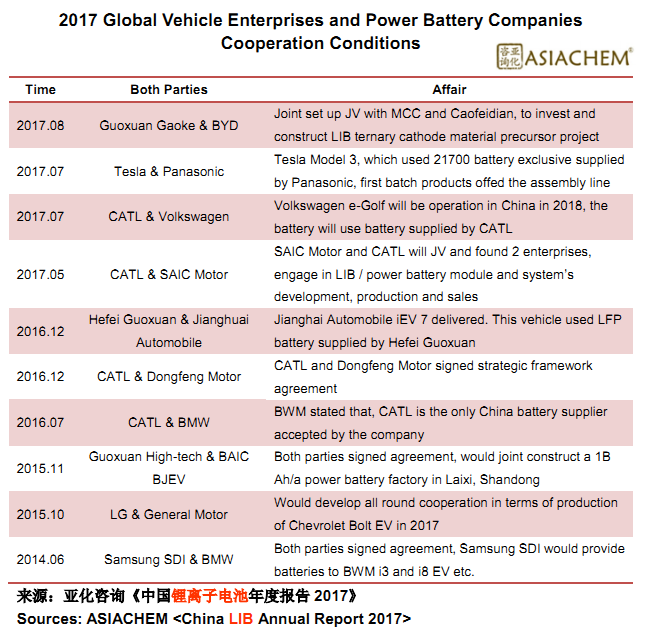At the end of Jul, 2017, Tesla Model 3 offed the assembly line. Before, at the beginning of the year, Tesla announced that the company and Panasonic 21700 battery which used in Model 3 mass production in Gigafactory. Information shows that, this 21700 battery system energy density is 300Wh/kg, 20% increase compare with 18650 battery which is used in previous Model S, monomer volume increases 35%, and system cost, however, reduces around 10%.
ASIACHEM ‘China LIB Annual Report 2017’ shows that, to ensure technology matching, steady supply and reasonable price of power battery used in NEV, global vehicle enterprises on one hand strengthen cooperation with power battery companies, on the other hand, which is more important is, global leading vehicle enterprises choose to self construct power battery plants one after another. In 2017, global vehicle enterprises and power battery companies’ cooperation conditions are shown as table below.

Except cooperate with power battery companies, in 2017, global vehicle enterprises self construct power battery capacity progresses are as below.
Daimler / BAIC Motor
Jul 2017, Daimler and BAIC Motor signed framework agreement in Germany. Both parties stated that, would joint invest CNY 5bn (about EU 655M), to construct BEV production base and power battery factory in Beijing Mercedes-Benz and produce Mercedes-Benz brands’ BEV products.
Daimler (Germany)
May 2017, Daimler announced to construct brand new super battery factory in Germany.
The factory locates in Kamenz Area, Regierungsbezirk Dresden, Germany and will be invested by Accumotive, its wholly owned subsidiary, with EU 500M and estimated to finish construction in 2018. Battery packs produced by this factory will be applied in Daimler’s commercial vehicles and passenger vehicles.
BMW
Jun 2017, Shenyang Environmental Protection Bureau of China stated that, BMW Brilliance Shenyang Engine Factory High Voltage Battery Center Project is now under closeout phase. According to information announced before, the project is expected to operation in 2017.
Information shows that, the project overall investment CNY 324.13M, mainly produce high energy battery packs using in G38 (brand new generation of BMW 5 Series), and capacity is 33k sets/a.
Jul 2016, Atchaka Sibunruang, Industry Minister of Thailand, said that BMW was considering building a new plug-in hybrid car power battery factory in Thailand. As reported, capital investment on the new factory may reach up to 2bnBaht (around USD57mn), and the construction would be started in mid-2017.
Lifan
Jul 2016, Lifan Industry released announcement, the company planned to raise no more than CNY 2.8bn funds. Among, CNY 890M would be used in 1.6GWh/a vehicle used LIB projects. The project total investment was CNY 1.19bn, and construction period was 12 months, would be implemented by Lifan Chongqing Wanguang New Energy Technology Co. Ltd.
Huatai Motor
Nov 2016, Huatai Motor LIB and NEV production base project started construction in Nanchuan Industry Park, Xining (National) Economic and Technological Development Zone. The factory total invested CNY 5bn, to construct 5GWh/a LIB project and whole vehicle project.
GEELY
May 2017, Geely Auto 500k sets/a new energy vehicle battery packs projects settled in Ningbo. It is reported that, the project total investment is CNY 5bn, mainly produce new energy vehicle batteries, electronic controlling systems and electric engines.
Mar 2017, Geely Zhejiang Hengyuan Power Battery Phase-2 and Hengyuan Battery Research Institute Project signing ceremony was held in Jinhua, Zhejiang. It is reported that, the project covers about 800Mu and plans to total invest CNY 6.5bn.
Before, in Apr, 2016, Jili Hengyuan Power Battery Project Phase-1 started construction in Jinhua. Project investment was CNY 2.05bn, designed annual capacity is 1.5M KWh, and estimates to pilot production in Aug, 2017.
ASIACHEM ‘China LIB Annual Report 2017’ shows that, Dec 2016, ‘Inform on Adjusting NEV Popularization and Application Financial Subsidy’ released, and started to implement on Jan 1, 2017. The ‘Inform’ points out that, under the premise of maintaining 2016-2020 subsidy policy overall stability, adjust NEV subsidy standard. Except fuel cell vehicles, each kind of vehicle type 2019-2020 central and local subsidy standard and upper limits will fall off 20% base on current standard.
Power battery cost occupies 40% cost of NEV whole vehicle, and it is its key part. Falling off of subsidy forced vehicle industries demand a lower power battery price. Through JV / self construct power battery factories can effectively reduce vehicle manufacturing cost. Public information shows that, Gigafactory, JV and constructed by Tesla and Panasonic, can reduce about 30% of their vehicle manufacturing cost.
ASIACHEM ‘China LIB Annual Report 2017’ shows that, in 2016, China power LIB capacity was as high as 101.95GWh, consumption, however, was only 27.4GWh, overcapacity was obvious; in 2017, China power LIB capacity will reach 146.18GWh.
Through cooperation with vehicle enterprises, power battery enterprises on one hand can ensure long-term selling income through ‘lock the customer’, on the other hand, power battery enterprises can not only deeper understand market requirement, improve its manufacturing process, increase production efficiency, to ensure core competitiveness in fierce market competition of power battery, but also can accumulate experiences of power battery products integration on new energy whole vehicles, through collecting application parameters, to lay a solid foundation for their future possibly technology extension.